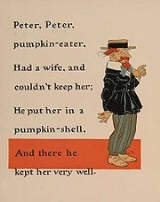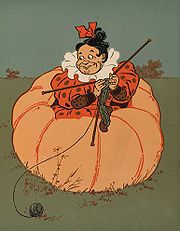
Peter Peter Pumpkin Eater
Encyclopedia
"Peter Peter Pumpkin Eater" is an English language
nursery rhyme
. It has a Roud Folk Song Index
number of 13497.
 Common modern versions include:
Common modern versions include:
As a result it is possible that the verse was an older one adapted to include pumpkins in America. This verse is also considered to be an older version of the rhyme Eeper Weeper
.
English language
English is a West Germanic language that arose in the Anglo-Saxon kingdoms of England and spread into what was to become south-east Scotland under the influence of the Anglian medieval kingdom of Northumbria...
nursery rhyme
Nursery rhyme
The term nursery rhyme is used for "traditional" poems for young children in Britain and many other countries, but usage only dates from the 19th century and in North America the older ‘Mother Goose Rhymes’ is still often used.-Lullabies:...
. It has a Roud Folk Song Index
Roud Folk Song Index
The Roud Folk Song Index is a database of 300,000 references to over 21,600 songs that have been collected from oral tradition in the English language from all over the world...
number of 13497.
Lyrics

- Peter, Peter pumpkin eater,
- Had a wife but couldn't keep her;
- He put her in a pumpkin shell
- And there he kept her very well.
- Peter, Peter pumpkin eater,
- Had another and didn't love her;
- Peter learned to read and spell,
- And then he loved her very well.
Origins
The rhyme is not present in any of the late eighteenth and early nineteenth century collections published in Britain. The first surviving version of the rhyme was published in Mother Goose's Quarto: or Melodies Complete, in Boston, Massachusetts around 1825. However, a verse collected from Aberdeen, Scotland and published in 1868 had the words:- Peter, my neeper,
- Had a wife,
- And he couidna' keep her,
- He pat her i' the wa',
- And lat a' the mice eat her.
As a result it is possible that the verse was an older one adapted to include pumpkins in America. This verse is also considered to be an older version of the rhyme Eeper Weeper
Eeper Weeper
"Eeper Weeper" or "Heeper Peeper" is a popular English nursery rhyme and skipping song that tells the story of a chimney sweep who kills his second wife and hides her body up a chimney. The rhyme has a Roud Folk Song Index number of 13497....
.

